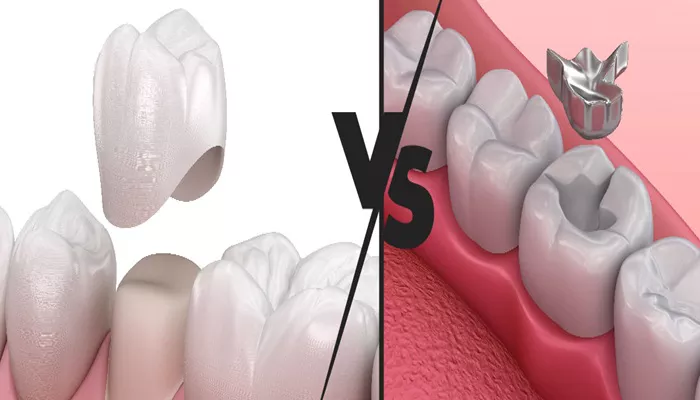In the realm of restorative dentistry, dental crowns and fillings are two of the most common procedures employed to address tooth damage and decay. While both treatments aim to restore the function and aesthetics of teeth, they serve different purposes and are used in varying circumstances. This article will delve into the distinctions between crowns and fillings, exploring their definitions, applications, materials used, procedures involved, costs, and longevity.
What Are Dental Crowns?
Definition and Purpose
A dental crown, often referred to as a cap, is a custom-designed restoration that encases the entire visible portion of a tooth above the gum line. Crowns are primarily used to restore teeth that are significantly damaged due to decay, trauma, or after a root canal procedure. Their primary purpose is to provide structural support and protect the underlying tooth structure from further damage.
Indications for Use
Crowns are recommended in several scenarios:
Severe Tooth Decay: When a tooth is extensively decayed and cannot support a filling.
Cracked or Fractured Teeth: To hold together pieces of a broken tooth.
Post-Root Canal Treatment: To protect a tooth that has undergone root canal therapy.
Cosmetic Improvement: To improve the shape or color of a discolored tooth.
What Are Dental Fillings?
Definition and Purpose
Dental fillings are materials used to fill cavities or holes in teeth caused by decay. The primary purpose of fillings is to restore the tooth’s shape and function while preventing further decay. Fillings can also be used for minor repairs, such as fixing chips or cracks in teeth.
Indications for Use
Fillings are suitable for:
Small to Moderate Cavities: Ideal for treating early-stage decay.
Minor Tooth Damage: Such as small chips or wear.
Cosmetic Enhancements: To improve the appearance of teeth by filling gaps.
Key Differences Between Dental Crowns and Fillings
Understanding the distinctions between crowns and fillings is essential for making informed decisions about dental treatment. Here are the primary differences:
| Feature | Dental Crowns | Dental Fillings |
| Coverage Area | Covers the entire tooth surface | Fills only specific areas affected by decay |
| Extent of Damage | Used for severe damage or significant decay | Suitable for minor damage or small cavities |
| Material Options | Made from porcelain, metal alloys, or ceramics | Commonly made from composite resin or amalgam |
| Durability | Generally lasts longer (10-15 years or more) | Typically lasts 5-15 years |
| Procedure Complexity | More complex; requires multiple visits | Simpler; usually completed in one visit |
| Cost | Generally more expensive | Usually less expensive |
Materials Used
The materials chosen for crowns and fillings vary significantly:
Crowns
Porcelain/Ceramic: Offers excellent aesthetics; ideal for front teeth.
Metal Alloys: Highly durable but less aesthetic; often used in back teeth.
Porcelain-Fused-to-Metal (PFM): Combines strength with aesthetics.
Fillings
Composite Resin: Tooth-colored material that blends well; suitable for visible areas.
Amalgam: Durable metal alloy; commonly used for posterior teeth due to its strength.
Glass Ionomer: Releases fluoride; often used in pediatric dentistry.
Procedure Overview
The procedures for obtaining crowns and fillings differ significantly in complexity and duration.
Getting a Crown
Initial Examination: The dentist assesses the tooth’s condition through X-rays.
Tooth Preparation: The affected tooth is reshaped by removing some enamel to accommodate the crown.
Impression Taking: An impression of the prepared tooth is made to create a custom crown.
Temporary Crown Placement: A temporary crown is placed while waiting for the permanent one.
Final Placement: Once ready, the permanent crown is cemented onto the tooth.
Getting a Filling
Cavity Assessment: The dentist examines the cavity size and location.
Decay Removal: The decayed portion of the tooth is removed using a dental drill.
Filling Application: The cavity is filled with the chosen material (composite resin, amalgam).
Shaping and Polishing: The filling is shaped to fit comfortably with surrounding teeth.
Cost Considerations
The cost of dental crowns generally exceeds that of fillings due to several factors:
Crowns require more extensive preparation and laboratory work.
Materials used for crowns can be more expensive than those used for fillings.
On average:
Crowns can range from $800 to $3,000 per tooth depending on materials and location.
Fillings, on the other hand, typically cost between $100 to $500 depending on the material used.
Longevity
Both crowns and fillings can last many years with proper care, but their longevity varies:
Crowns usually last between 10 to 15 years or more if maintained properly through good oral hygiene practices.
Fillings generally have a lifespan of 5 to 15 years depending on material type, location in the mouth, and patient habits.
Conclusion
In summary, dental crowns and fillings serve distinct purposes in restorative dentistry. Crowns provide comprehensive coverage and protection for severely damaged teeth, while fillings are ideal for addressing smaller cavities and minor damage. Understanding these differences allows patients to make informed decisions regarding their dental health based on their specific needs.
When faced with dental issues, consulting with a qualified dentist is crucial. They can evaluate your condition and recommend whether a crown or filling is appropriate based on the extent of damage, aesthetic considerations, and long-term oral health goals. Regular dental check-ups can help prevent extensive damage that may require more invasive treatments in the future.
Related topics:

